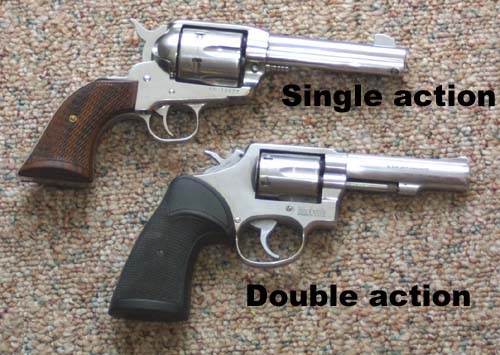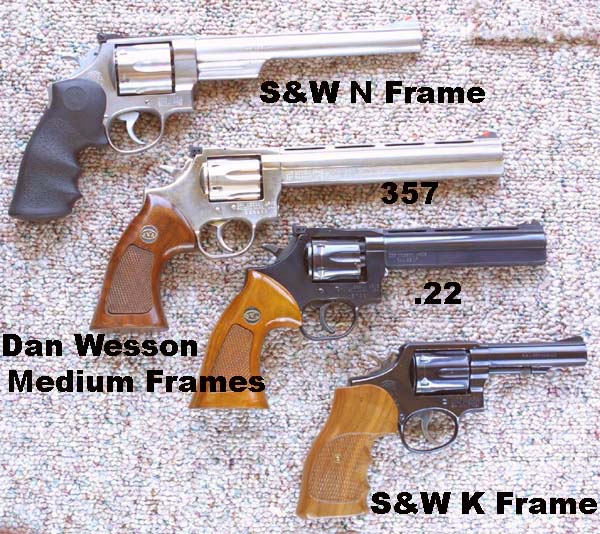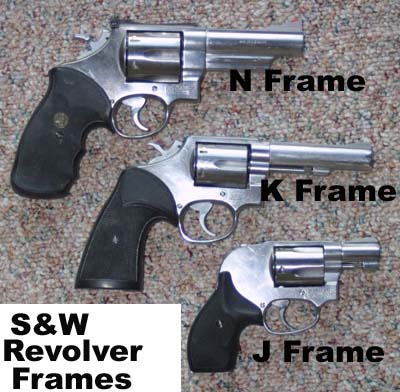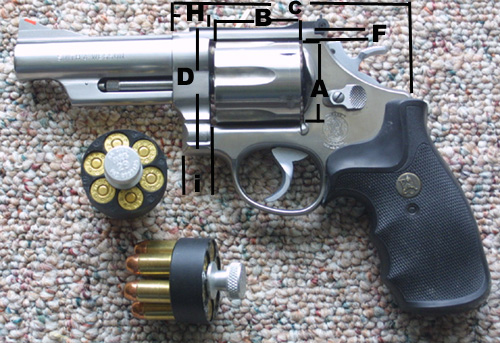 numbered. The double action guns could be fired by merely pulling
their triggers. Though this resulted in a much longer and heavier trigger
pull, it greatly increased the rate of fire. For those who preferred
the single action style of trigger pull, the new series of double action
revolvers could still be fired in single action mode. No one has taken the
old style single action revolver seriously as a combat arm for decades,
though they are still as deadly as they ever had been. There has been a
great resurgence in interest among hunters, and cowboy action shooters.
numbered. The double action guns could be fired by merely pulling
their triggers. Though this resulted in a much longer and heavier trigger
pull, it greatly increased the rate of fire. For those who preferred
the single action style of trigger pull, the new series of double action
revolvers could still be fired in single action mode. No one has taken the
old style single action revolver seriously as a combat arm for decades,
though they are still as deadly as they ever had been. There has been a
great resurgence in interest among hunters, and cowboy action shooters.
Everyone knows that revolvers are obsolete, at least as far as combat use is concerned. All one has to do, to prove this, is to look at television, and the movies. If revolvers are carried by any of the featured players, they are usually for hunting, or target practice, or else it is an older character, set in his ways, and not amenable to the more advanced weapons of the day. If this is not enough, surely the example of the military, which abandoned the revolver, in favor of the semi auto at the turn of the century, should prove the point. Even the police, long a great supporter of the revolver, are flagging in their loyalties. For the past several decades, American law enforcement agencies have been divesting themselves of their trusty revolvers, in favor of a new breed of enhanced automatics.
In particular, the introduction of a competing series of "wonder nine" semi auto pistols has pounded several nails into the
 casket of the revolver, for police and military use. The wonder
nines are popular, nine millimeter automatics with large double column
magazines, and generally feature double action triggers. In many cases,
since the introduction of the trend setting Glock, these pistols are constructed
partially out of polymer. The pattern was set in 1935 by the Browning P-35
(Hi power) pistol. This was a 9mm handgun with a double column magazine,
a fully supported chamber, and a cam system for tipping the barrel. In
future years, features, such as a double action trigger, and alloy frame,
would be added. These additions further defined the breed.
casket of the revolver, for police and military use. The wonder
nines are popular, nine millimeter automatics with large double column
magazines, and generally feature double action triggers. In many cases,
since the introduction of the trend setting Glock, these pistols are constructed
partially out of polymer. The pattern was set in 1935 by the Browning P-35
(Hi power) pistol. This was a 9mm handgun with a double column magazine,
a fully supported chamber, and a cam system for tipping the barrel. In
future years, features, such as a double action trigger, and alloy frame,
would be added. These additions further defined the breed. When I first became interested in firearms, and particularly in pistols, revolvers held no particular attraction for me. I have, for years, been a great believer in the semi automatic handgun, particularly as embodied in the 45 A.C.P., and the 1911 pattern pistol. Despite these prejudices, I am not totally blind to the merits of the revolver. They had always struck me as being nice traditional firearms, slow to load, and limited in capacity, but sturdy and dependable. The real romance, and excitement was in the cutting edge of handgun development. This was, of course, the domain of the semi auto. Like many young gun enthusiasts of the time, I had no desire to tread the back waters of handgun shooting, by using a revolver. Funny thing though, my first pistol was a revolver (a Police Positive), as were my third, and fourth. Many years passed, before I was to buy another revolver, though I made many purchases of semi autos during the intervening years.
Being a confirmed semi auto shooter, for many years, I owned a number of .45, and 9mm automatics. Despite this, I always seemed to do just a little bit better, shooting one of my revolvers. It also seemed that a revolver tended to come along with me for sport and recreational shooting. The automatics were saved for "serious" shooting. Ironically, the lack of esteem in which I held revolvers, meant that I tended to use them more often, bringing one along as a knock around, or carry gun, on travels or camping trips. I have always found a trusty revolver to be dependable, simple to use, and forgiving of spotty field maintenance.
Despite their virtues, revolvers do have some significant disadvantages. They are heavy, and bulky, particularly around the
 cylinder. They are limited in capacity, usually to six rounds, though
there are some which hold as many as eight rounds. Some .22 rimfire
revolvers can hold as many as ten. They are slow to reload. They are difficult
to repair, and though durable, the internal lockwork is quite delicate,
if it should ever be exposed or contaminated. These things can make the
revolver tactically, and logistically limited, when viewed on a large
scale. In light of these considerations, the military abandoned general
issue of the revolver, just around the time of the First World War, though
there was still large scale use of wheelguns up until Viet Nam (and smaller
scale use, even today). In general though, the weaknesses of the revolver
outweigh the strengths, in military use.
cylinder. They are limited in capacity, usually to six rounds, though
there are some which hold as many as eight rounds. Some .22 rimfire
revolvers can hold as many as ten. They are slow to reload. They are difficult
to repair, and though durable, the internal lockwork is quite delicate,
if it should ever be exposed or contaminated. These things can make the
revolver tactically, and logistically limited, when viewed on a large
scale. In light of these considerations, the military abandoned general
issue of the revolver, just around the time of the First World War, though
there was still large scale use of wheelguns up until Viet Nam (and smaller
scale use, even today). In general though, the weaknesses of the revolver
outweigh the strengths, in military use. Police were a bit more hesitant than the military, to take up the automatic, in place of the revolver, for what were latter discovered to be some pretty good reasons. Unlike the military, the police force is not primarily considered to be an armed force. Though police officers do carry firearms, and are trained, and expected to use them if needed, they are not an offensive force. Most police officers, even in today's crime ridden streets, will never draw their guns. The vast majority will never have to shoot another human being. While the military and police both receive weapons, and self defense training, that of the police is given far less emphasis than that of the military. Most police administrators did not consider the firepower advantage of the semi auto to be as important as the simplicity and safety advantages of the revolver. Even today, as attitudes are changing, and many departments are adapting the semi auto, there are calls for double action only triggers, mimicking the action of the old revolvers.
The revolver, and the newly armed citizen
As more states become firearm friendly, and the number which institute "shall Issue" carry permits increase, a large number of people are expected to become firearms owners, and users. The problem here, is that many of the newcomers had no previous interest in guns. The more restrictive laws of a few decades ago, tended to confine interest to hobbyists, collectors, military buffs, and competitive shooters. These types of people are gun savvy, safety conscious, and are very aware of what had once been called "the way of the gun." The new influx of users, by and large, are not, and have no wish to be. It may be, that you are one of these people, and have no real interest in guns, but do have a strong interest in your own well being, and defense. Though many gun enthusiasts look down on this type of thing, I see it as being no worse than the average car owner, who has little interest in the mechanics of automobiles, and is not involved in motor sports, but does wish to be able to drive to work, get to the store, and take the occasional trip by car.
For the beginner, just starting out in the sport, or the householder desiring a bit of protection, but not certain about the amount of skill and involvement which will be developed, the traditional suggestion is to purchase a medium frame revolver, in 38 (or better yet, 357) caliber. I can make no better recommendation than this, for several reasons. They are:
- Low cost. There is a real glut of used revolvers, right now, in the gun market, and the situation will likely remain so for years. In large measure, this is due to the efforts of US police departments to replace the traditional revolver with the new breed of semi auto pistol. Good quality, used revolvers can be picked up for around $200, more or less. New, good quality revolvers, may be had for less than $300, from, companies like Taurus. The cheaper models can be had in the $100 range, or less, but I do not recommend their purchase.
- Ease of use. There is no gun easier for the novice user to learn, than the double action revolver.
- Always ready. A loaded revolver only requires a pull on the trigger, in order to fire. There are no safeties to take off, no slide to pull back, and no magazine to seat.
- Safe. An uncocked, double action revolver, of modern design, can not be made to fire, except by a long pull of the trigger.
- Dependable. A misfire (rare though they are) will not disable a revolver, there is no such thing as a failure to feed, no such thing as a jam or a stovepipe. A revolver is not affected by the stiffness of the user's grip, or by the method of gun handling.
- Powerful. In 38/357, the shooter has the option of employing the very powerful .357 Magnum, or easing into the development of shooting skills with the more forgiving .38. The .38 itself is no slouch. Comparison of ballistic tables shows the .38 to equal, or slightly surpass (heavier bullets) the over rated 9mm.
I hesitate to suggest particular models, because condition, and availability vary from place to place. However, I have put together a sort of a guideline to work from. I assume that the beginner does not expect to pay a great deal of money, and so I advocate the purchase of a used revolver. This is where the greatest savings can be made, since production of new revolvers can cost as much or more than that of the more popular semi automatics. There are exceptions of course, as with heavy magnum, or target guns. The guns below, are all high quality weapons which will remain serviceable longer than most of us will be alive. Unlike small cheap pistols, used by many beginners, most shooters will still find the guns listed below, to be satisfactory for use, even after their skills have increased.
Used guns for the novice shooter. Prices can vary by location, and are approximate at the time of this writing ( mid 2002):
- S&W K frame revolvers (M-10, 15, 13, 19) These have been the traditional police guns for decades, and have much to recommend them. ($150-$300)
- S&W stainless K frames (M-64, 65, 66, 67) These are stainless versions of the classic duty guns. Expect to pay $50 or so more (used) than the cost of similar models rendered in standard blue steel. ($225-$350)
- Colt Police positive A classic, medium frame gun by Colt. This is comparable to the medium frame Smith, and is the same frame, as that used by the Detective Special. ($200-$400)
- Colt Lawman or trooper The Colt entry in the duty gun market. These were a bit heavier than the Police Positive, but not quite up to the level of the Python. These guns had simplified actions ($250-$400)
- Ruger medium frame series These guns are of more modern design than the classic S&W, Colt, or others, like the Taurus, which are close copies. The Rugers use modular components, and were designed with CNC production methods in mind. Ruger was one of the earlier manufacturers to make extensive use of stainless steels.($175-$300)
- Any Taurus in 38 or 357 The Taurus duty guns are clones of the S&W revolvers and are of similar quality to that of the S&W duty guns. ($150-$300)
- Know what you want Like most things, choosing a firearm is better, if you have a logical plan, and stick with it.
- Be aware of legal requirements This is mostly a problem in california, new jersey, illinois, and new york, though there can be difficulties in other places which are Constitution impaired, or where lawmakers are ignorant of the values of the nation they presume to govern.
- Be patient, or be willing to spend a bit more. This is true in most things, but is particularly applicable to the used gun buyer. We have a wonderful, free market, in which anyone can buy nearly anything for a price. This can work for the patient buyer, but will work against those who are in a hurry.
- Look used guns over carefully, and test fire them, if you can. This is less of a problem with a dealer, than with a private seller. It is also less of a consideration with standard calibers, than with magnums.
- Do not buy a gun which has been altered, or has obviously been owner serviced. You are just asking for problems, if you ignore this one. Unlike cars, firearms should rarely need service, and should never be owner modified, unless the owner possesses gunsmithing skills. This could also get you into legal trouble, if you should ever end up shooting in self defense.
- Stay away from the .25 auto I mention this in particular, because it is such a common mistake among frugal gun buyers. Though there are a few high quality 25 autos out there, most are just plain trash, and you don't want to stake your life on them. Even in quality guns, such as the Browning or Beretta, the cartridge itself is a poor stopper, and not very accurate. On top of everything else, 25 ammunition is expensive, generally costing more than .38 special cartridges. If you are determined to buy a compact, small caliber pistol, go with the .22 Long rifle instead.
- Easy to reload for: The reloader has a variety of loads to choose from, everything from squib loads (very light, for practice or recreation) to high pressure loads, driving a variety of bullet weights. Semi auto pistols do not offer this degree of flexibility, since a balance must be maintained between loads with enough power to drive the springs, but not enough to batter the slide against the frame. Revolvers are also not as sensitive to crimping, since they do not headspace on the crimp, as do automatics.
- Can be chambered for magnum cartridges: The most powerful pistol cartridges, the magnums, are all revolver rounds. Though it is true, that some automatics (notably the desert eagle) are chambered for magnums, these are still revolver rounds, and designing an automatic to fire them, results in a very large, expensive, heavy, and complex gun.
- Are not particular about bullet type, and shape: There is no such thing as a failure to feed in a revolver. This is regardless of bullet weight, cartridge length, or bullet style.
- Are not sensitive to variations in powder charges: This has already been alluded to above, but bears specific mention. These guns are amazingly flexible, in the ammunition they digest, compared to the rather fussy appetite of the auto loading pistol.
- Are not rendered useless by dirt or poor lubrication (though I wouldn't make a habit of it): Though poor cleaning and lubrication will eventually render any gun useless, the revolver is a bit more hardy. A gummed up revolver might develop a heavy trigger pull, and a filthy cylinder will make reloading a bit more difficult, but the gun will still fire.
Unfortunately, firearms designers have stuck to some outdated design concepts. At the turn of the century, there was nothing like today's science of ergonomics. While some designers seemed to have a sense about how things should look, feel, and work, there was no methodical study of how humans should interact with mechanical devices. These turn of the century grips were designed wide at the base, with a bit of a taper towards the top. This does not really fit the anatomy of the hand. We tend to have a wider grip at the top of the hand, which narrows toward the bottom, as the palm and fingers get smaller. The designers of such items as joysticks, and baseball bats, have taken this to heart, and generally design their products to taper towards the base. Many gun designers, as well as a number of target, and combat shooters are aware of this, and a series of custom grips has been marketed. These after market grips are well worth the price, and WILL improve your shooting, if properly selected. The best design is the reverse wedge. These generally have finger cut outs, but more importantly, they are narrower at the base, and increase in width towards the top. When I skeptically tried my first set, I couldn't believe the difference. The gun seemed to automatically home in on the target. They were also very comfortable to shoot, making the gun feel like an extension of the hand. Though I do not generally recommend custom grips for automatics (they tend to harm the handling qualities of the gun), I recommend them without hesitation for the revolver.
Still, nothing is without it's drawbacks; there is no perfection in the world. If the revolver had been the final answer in hand gun development, the semi auto pistol would never have gone into production. The main drawbacks of the revolver are:
- Firepower: The revolver is generally limited to six shots.
- Bulk: Though a revolver can be made very short, the width of the cylinder makes it difficult to keep these guns from being a bit too thick for easy concealment.
- Double action pull: The only way to fire a revolver quickly, is by a full stroke of the double action trigger.
- Slow to reload: Not being magazine fed, the chambers of a revolver must all be emptied, and then refilled. Speed loaders can make this process almost as fast as with a magazine fed firearm, but are not in widespread use.
- Difficult to repair and tune: Though revolvers are generally more dependable, and hardy in the field, than the semi auto, a malfunctioning revolver is much more difficult to repair than a semi automatic. Revolvers can also go out of tune, a situation in which the cylinder is not exactly lined up with the barrel at the moment of firing. Even a minuscule error in tune can destroy accuracy, and cause the revolver to spit lead shavings in the face of the shooter. Very unpleasant!
Revolvers are likely to be around for a great number of years to come. If our grandchildren are still permitted to own guns (to say nothing of sports cars, and pick up trucks), by whatever form their government takes, it is likely that there will still be arguments over the strengths and weaknesses of revolvers, and automatics. It is an argument which will never be settled, because it is a question with no one right answer.
Comparative measurements of various revolver framesCaliper measurements taken from my personal collection. |
||||||||||
Revolver model |
A cylinder width |
B cylinder length |
C frame length |
D frame height |
E thickness |
F top strap |
G bottom strap |
H front max |
I front min |
J front thick |
| S&W N Frame (m29) |
1.75" |
1.7" |
4.9" |
2.45" |
.66" |
.21" |
.49" |
.84" |
.65" |
.26" |
| S&W K Frame (m13) |
1.45" |
1.65" |
4.5" |
2.25" |
.55" |
.24" |
.52" |
.63" |
.5" |
.25" |
| S&W J Frame (m49) |
1.31" |
1.54" |
4." |
1.92" |
.54" |
.17" |
.42" |
.57" |
.45" |
.19" |
| Ruger Redhawk (44) |
1.78" |
1.76" |
4.79" |
2.7" |
.75" |
.34" |
.55" |
.77" |
.62" |
.41" |
| Dan Wesson medium (357) |
1.48" |
1.64" |
4.5" |
2.41" |
.65" |
.32" |
.58" |
.6" |
.54" |
.4" |
| Dan Wesson Large (44) |
1.78" |
1.78" |
5.04" |
2.75" |
.68" |
.35" |
.52" |
.62" |
.71" |
.29" |
| Colt D frame (det special) |
1.41" |
1.56" |
4.19" |
2.04" |
.57" |
.19" |
.42" |
.58" |
.5" |
.19" |
| Tauras Raging Bull (454) |
1.78" |
1.83" |
4.81 |
2.7" |
.63" |
.3" |
.51" |
.78" |
.65" |
.3" |

|